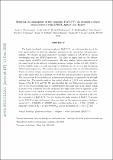Studying the atmosphere of the exoplanet HAT-P-7b via secondary eclipse measurements with EPOXI, Spitzer and Kepler
Author(s)
Seager, Sara; Madhusudhan, Nikku; Christiansen, Jessie L.; Ballard, Sarah; Charbonneau, David; Matthew J., Holman; Wellnitz, Dennis D.; Deming, Drake; A'Hearn, Michael F.; EPOXI team; ... Show more Show less
DownloadSeager_Studying the.pdf (680.6Kb)
OPEN_ACCESS_POLICY
Open Access Policy
Creative Commons Attribution-Noncommercial-Share Alike
Terms of use
Metadata
Show full item recordAbstract
The highly irradiated transiting exoplanet, HAT-P-7b, currently provides one of the best opportunities for studying planetary emission in the optical and infrared wavelengths. We observe six near-consecutive secondary eclipses of HAT-P-7b at optical wavelengths with the EPOXI spacecraft. We place an upper limit on the relative eclipse depth of 0.055% (95% confidence). We also analyze Spitzer observations of the same target in the infrared, obtaining secondary eclipse depths of 0.098% ± 0.017%, 0.159% ± 0.022%, 0.245% ± 0.031%, and 0.225% ± 0.052% in the 3.6, 4.5, 5.8, and 8.0 μm IRAC bands, respectively. We combine these measurements with the recently published Kepler secondary eclipse measurement and generate atmospheric models for the dayside of the planet that are consistent with both the optical and infrared measurements. The data are best fit by models with a temperature inversion, as expected from the high incident flux. The models predict a low optical albedo of lsim0.13, with subsolar abundances of Na, K, TiO, and VO. We also find that the best-fitting models predict that 10% of the absorbed stellar flux is redistributed to the nightside of the planet, which is qualitatively consistent with the inefficient day-night redistribution apparent in the Kepler phase curve. Models without thermal inversions fit the data only at the 1.25σ level, and also require an overabundance of methane, which is not expected in the very hot atmosphere of HAT-P-7b. We also analyze the eight transits of HAT-P-7b present in the EPOXI data set and improve the constraints on the system parameters, finding a period of P = 2.2047308 ± 0.0000025 days, a stellar radius of R sstarf = 1.824 ± 0.089 R sun, a planetary radius of Rp = 1.342 ± 0.068 R Jup, and an inclination of i = 85.7+3.5 –2.2 deg.
Date issued
2010-01Department
Massachusetts Institute of Technology. Department of Earth, Atmospheric, and Planetary SciencesJournal
Astrophysical journal
Publisher
Institute of Physics
Citation
Jessie L. Christiansen et al. "Studying the atmosphere of the exoplanet HAT-P-7b via secondary eclipse measurements with EPOXI, Spitzer and Kepler." 2010 Astrophysical Journal 710 97-104. © IOP Publishing 2010.
Version: Author's final manuscript
ISSN
0004-637X